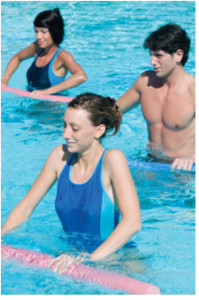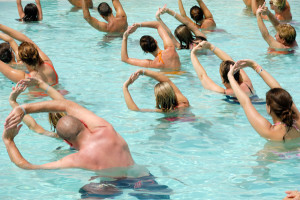Aquatic rehabilitation consists of planned, progressive physical exercises to reduce the chance of further injury, enhance function, and optimize overall fitness and health. Commonly seen diagnoses include musculoskeletal injuries to include simple to complex fractures, spinal cord injuries, and amputations. This group also includes patients with Traumatic Brain Injuries, Post Traumatic Stress, Encephalopathy, Co-addictions, and seizures from resultant brain trauma.The primary goal in planning the rehabilitation program is to introduce specialized programming to speed healing, provide a setting to achieve success, and mainstream into programs currently available.
 It has been shown that aquatic training combined with land training can elevate recovery faster than land training alone. Aquatic rehabilitation is the avenue to return to sport specific functional exercise earlier than exclusive land training. Water is the safest place to rehabilitate as it allows graded weight bearing, full range of motion, and resistance training. The important point is to understand proper adaptation of exercises in order to achieve goals.
It has been shown that aquatic training combined with land training can elevate recovery faster than land training alone. Aquatic rehabilitation is the avenue to return to sport specific functional exercise earlier than exclusive land training. Water is the safest place to rehabilitate as it allows graded weight bearing, full range of motion, and resistance training. The important point is to understand proper adaptation of exercises in order to achieve goals.
In 2010, the Army Surgeon General’s office funded the development and analysis of Aquatic Rehabilitation for Wounded Warriors. Study requirements included providing a regular workout of sufficient intensity and duration to improve fitness equal to an elite athlete, hasten return to active duty, and a viable option to swimming as most were not swimmers. Since the focus of the program was physical conditioning, it was important to prevent overtraining, improve function, improve fitness, and improve quality of life within their limitations. Evaluations used in the Performance Improvement study validated land-based scales for pain, the Modified Oswestry Low Back Pain Disability questionnaire, the Upper Extremity Scale, and the Lower Extremity Scale. In order to evaluate improved cardio respiratory fitness, the 100 Step Test was developed. The 100 Step Test required the patient to have adequate flotation whiletethered to a pool wall then take 100 steps with a 45-90° knee lift as fast as possible counting only their dominant leg – their heart rate was recorded before and after along with the time it took to complete.
The focus on musculoskeletal injuries revealed that 52% had lower extremity injuries, 26% had low back pain/injury, and 22% had upper extremity injuries. Although low back pain had the fewest responses, its pain rate was the highest. Baseline information on the Low Back disability questionnaire scored 57% requiring prescription medication to get through daily activities, 80% had increased pain with standing, and 68% required prescription sleep medication to an average of 2 to 6 hours of sleep per night. This amount of sleep is inadequate for daily recovery. Upper extremity injuries were not significantly impacted by aquatic exercise.
Aquatic rehabilitation was important as over half of the participants reported moderate to extreme difficulty in performing basic functional land tasks; i.e. weight-bearing, walking/running, general fitness activities. The Lower Extremity Functional Scale with the Army showed the percentage of subjects with moderate to extreme difficulty ranged from: Hobbies/recreation – 66%, Walking 1 mile – 64%, Standing 1 hour – 67%, to Running– 79% to 84%.In the Marine Corps, musculoskeletal injuries are the leading non-combat related cause of outpatient visits and hospitalization. An average of 15 duty days was lost for each injury at an average cost of $1900 each. The primary cause was overtraining on land.
The 100 Step Test assessed the success of one of the main components of the rehab training program. The keystone of the training program was Deep Water Cadence Training. This regimen provides a non-impact cardio option. All patients can work at their potential. Heart rates are tracked using heart rate monitors. Once step pace is determined, intervals vary from 30 seconds to 5 minutes with 30 second recovery between sets. Results after six months averaged a reduction of 6 beats per minute, ending heart rate increased 7 beats per minute, and time to complete the 100 steps decreased an average of 11 seconds.
The findings to meet the goals for patients with musculoskeletal injuries led to program components of deep water interval cadence training, shallow water walking/running (as tolerated), core strength, balance challenges, upper and lower extremity exercises using resistive equipment (AquaLogix preferred), agility, Plyometrics, and flexibility/stretching. Athletes are able to practice their specific sport movement patterns in the pool. Patients with brain trauma were introduced to Ai Chi – a mindfulness program that improves balance and resets neuromuscular training.
 These patients want to be challenged with their rehabilitation program. This translates to regulating the intensity of exercise and adapting to each patient. The three components that must overlap include the physiological – response to the exercise; performance – correct execution of the exercise; and, perception – belief in the benefits of the exercise. Balance, coordination, and flexibility are the foundation of all movement. Once these are achieved, then specifics can be addressed.
These patients want to be challenged with their rehabilitation program. This translates to regulating the intensity of exercise and adapting to each patient. The three components that must overlap include the physiological – response to the exercise; performance – correct execution of the exercise; and, perception – belief in the benefits of the exercise. Balance, coordination, and flexibility are the foundation of all movement. Once these are achieved, then specifics can be addressed.
Static positioning is used for strength acquisition and range of motion. Remaining stable while reaching outside of neutral balance and not falling demonstrates the ability to use both the segmental and global muscles to return to center. Core strength precedes all other movement as movement initiates in the core. Ai Chi, Aqua Pilates, and Yoga are examples of where to begin. Development of strength in the extremities is accelerated with drag equipment, such as the AquaLogix bells and blades. The combination of core strength and muscle strength provide the ability to move outside of neutral without loss of balance.
Fluid movement challenges body alignment. The ability to add together exercises or movements increases endurance. Strength and endurance enable changes of position and increased time of exercises. Conditioning can only occur when static and fluid exercises are combined. All planes of motion and transition between planes enables fluidity in completion of the exercises. Rehabilitation sessions should include core, balance, cardio respiratory, muscular strength and endurance, and agility exercises. Exercises for the athlete should incorporate skills needed for their sport.
Any type of injury is traumatic. The injured person has many questions and concerns. In addition to a musculoskeletal injury, the patient may also have suffered a concussion or a traumatic brain injury, even a mild one. Even though not visible, pain, balance, depression, and anxiety may be present. Depending upon the injury, brain trauma of any type may affect or slow the progression of more aggressive rehabilitation exercises. The recommendation is to include Ai Chi, or selected Ai Chi movements in the protocol developed for each session.
The motivated patient is the easiest but often the most challenging to rehabilitate. You must control the intensity of the session. Proper equipment selection is essential and a broad background in options and exercise adaptation encourages compliance. The therapist or practitioner providing the rehabilitation must remain in charge and develop a plan that supports achievable goals and concurs with land goals.
 Mary O. Wykle, PhD, ATRIC, AEA is the recipient of the International Swimming Hall of Fame Adapted Aquatics Award. Mary is the recipient of numerous national and international awards including the ATRI Aquatic Therapy Professional Award, the Tsunami Spirit Award, and the Dolphin Award. She has also received the AEA Lifetime Achievement Global Award. Additionally, she is past Chair of the College of Physical Activity and Sports Sciences Visiting Committee for WVU and a member of the Hall of Fame.
Mary O. Wykle, PhD, ATRIC, AEA is the recipient of the International Swimming Hall of Fame Adapted Aquatics Award. Mary is the recipient of numerous national and international awards including the ATRI Aquatic Therapy Professional Award, the Tsunami Spirit Award, and the Dolphin Award. She has also received the AEA Lifetime Achievement Global Award. Additionally, she is past Chair of the College of Physical Activity and Sports Sciences Visiting Committee for WVU and a member of the Hall of Fame.
References
Becker BE. Aquatic therapy: scientific foundations and clinical rehabilitation applications. Phys Med Rehabil Cli. 2009;1(9):859-72.
Dundar U, Solak O, Yigit I, Evcik D, Kavuncu V. Clinical effectiveness of aquatic exercise to treat chronic low back pain: a randomized controlled trial. Spine. 2009;34(14):1436-40.
Fairbank JC, Pynsent PB. The Oswestry Disability Index. Spine. 2000;25(22):2940-52.
Finch E, Brooks D, Stratford P, Mayo N. Physical rehabilitation outcome measures: a guide to enhanced clinical decision making. J NeuroEng Rehabil. 2005;2(2):1-4.
Konlian C. Aquatic therapy: making a wave in the treatment of low back injuries. OrthopNurs. 1999;18(1):11-8.
Macedo LG, Latimer J, Maher CG, et al. Effect of motor control exercises versus graded activity in patients with chronic nonspecific low back pain: a randomized controlled trial. Phys Ther. 2012;92(3):363-77.
Mentor: Jon Nettie, PT., et. al. AquaLogix vs. “Standard” Aquatic Equipment In Cardinal and Multiplanar (PNF) Patterns with Patients Who Have Non-Descript Low Back Pain
Pengel HM, Maher CG, Refschauge KM. Systematic review of conservative interventions for subacute low back pain. Clin Rehabil. 2002;16(8):811-20.
Stout T. AquaLogix Fitness. AquaLogix. 2012. Available at http://www.aqualogixfitness.com/. Accessed March 29, 2012.
Waller B, Lambeck J, Daly D. Therapeutic aquatic exercise in the treatment of low back pain: a systematic review. Clin Rehabil. 2009;23(1):3-14.
Prins JH, Kimura I, Turner M, Weisbach M, Lehoullier L. The application of kinematic motion analysis in the evaluation of therapeutic exercises used in aquatic rehabilitation. Arch Phys Med Rehabil. 2006;87.
Wykle, MO, PhD. Aquatic Program Development for Wounded Warriors, Palaestra, 2014.
Wykle, MO, PhD. Aquatic Rehabilitation for Wounded Warriors. U.S. Army Surgeon General Office. 2011.
Wykle, MO, PhD. Aquatics Maximum Power – Intense Training (AMP-IT), U.S. Marine Corps, MCCS Division. 2013.
Wykle, MO, PhD. Aquatic Exercises for Injured Warriors and Athletes. DVD, 2012.
Wykle, MO, PhD. Aqua Pi-Yo-Chi DVD. 2006.
Wykle, MO, PhD. Lumbar Stabilization and Progression DVD. 2010.
Wykle, MO, PhD. Transitioning Yoga and Pilates between Land and Water (3rd ed.), 2013.

